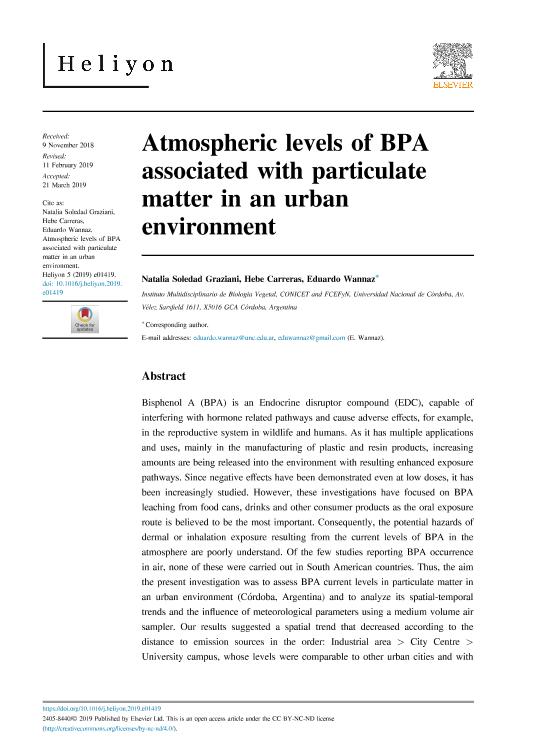Mostrar el registro sencillo del ítem
dc.contributor.author
Graziani, Natalia Soledad

dc.contributor.author
Carreras, Hebe Alejandra

dc.contributor.author
Wannaz, Eduardo Daniel

dc.date.available
2020-09-08T22:14:29Z
dc.date.issued
2019-04
dc.identifier.citation
Graziani, Natalia Soledad; Carreras, Hebe Alejandra; Wannaz, Eduardo Daniel; Atmospheric levels of BPA associated with particulate matter in an urban environment; Elsevier Ltd; Heliyon; 5; 4; 4-2019
dc.identifier.uri
http://hdl.handle.net/11336/113577
dc.description.abstract
Bisphenol A (BPA) is an Endocrine disruptor compound (EDC), capable of interfering with hormone related pathways and cause adverse effects, for example, in the reproductive system in wildlife and humans. As it has multiple applications and uses, mainly in the manufacturing of plastic and resin products, increasing amounts are being released into the environment with resulting enhanced exposure pathways. Since negative effects have been demonstrated even at low doses, it has been increasingly studied. However, these investigations have focused on BPA leaching from food cans, drinks and other consumer products as the oral exposure route is believed to be the most important. Consequently, the potential hazards of dermal or inhalation exposure resulting from the current levels of BPA in the atmosphere are poorly understand. Of the few studies reporting BPA occurrence in air, none of these were carried out in South American countries. Thus, the aim the present investigation was to assess BPA current levels in particulate matter in an urban environment (Córdoba, Argentina) and to analyze its spatial-temporal trends and the influence of meteorological parameters using a medium volume air sampler. Our results suggested a spatial trend that decreased according to the distance to emission sources in the order: Industrial area > City Centre > University campus, whose levels were comparable to other urban cities and with the temporal trend showing a higher prevalence of the compound in the colder months. Wind speed (WS), temperature (T), atmospheric pressure (AP) and relative humidity (RL) were the most influenced variables. However daily values are unpredictable and depend mainly on the emission sources and punctual events that release BPA into the atmosphere. No risk factor could be quantified since there is no reference value for this exposure route; Nevertheless, this study represents the first approach and provides data about this emergent pollutant in and Argentinean city, thus contributing to global BPA studies.
dc.format
application/pdf
dc.language.iso
eng
dc.publisher
Elsevier Ltd
dc.rights
info:eu-repo/semantics/openAccess
dc.rights.uri
https://creativecommons.org/licenses/by-nc-sa/2.5/ar/
dc.subject
ATMOSPHERIC SCIENCE
dc.subject
ENVIRONMENTAL SCIENCE
dc.subject
HEALTH SCIENCES
dc.subject.classification
Otras Ciencias de la Tierra y relacionadas con el Medio Ambiente

dc.subject.classification
Ciencias de la Tierra y relacionadas con el Medio Ambiente

dc.subject.classification
CIENCIAS NATURALES Y EXACTAS

dc.title
Atmospheric levels of BPA associated with particulate matter in an urban environment
dc.type
info:eu-repo/semantics/article
dc.type
info:ar-repo/semantics/artículo
dc.type
info:eu-repo/semantics/publishedVersion
dc.date.updated
2020-09-02T19:13:42Z
dc.identifier.eissn
2405-8440
dc.journal.volume
5
dc.journal.number
4
dc.journal.pais
Países Bajos

dc.journal.ciudad
Amsterdam
dc.description.fil
Fil: Graziani, Natalia Soledad. Consejo Nacional de Investigaciones Científicas y Técnicas. Centro Científico Tecnológico Conicet - Córdoba. Instituto Multidisciplinario de Biología Vegetal. Universidad Nacional de Córdoba. Facultad de Ciencias Exactas Físicas y Naturales. Instituto Multidisciplinario de Biología Vegetal; Argentina
dc.description.fil
Fil: Carreras, Hebe Alejandra. Consejo Nacional de Investigaciones Científicas y Técnicas. Centro Científico Tecnológico Conicet - Córdoba. Instituto Multidisciplinario de Biología Vegetal. Universidad Nacional de Córdoba. Facultad de Ciencias Exactas Físicas y Naturales. Instituto Multidisciplinario de Biología Vegetal; Argentina
dc.description.fil
Fil: Wannaz, Eduardo Daniel. Consejo Nacional de Investigaciones Científicas y Técnicas. Centro Científico Tecnológico Conicet - Córdoba. Instituto Multidisciplinario de Biología Vegetal. Universidad Nacional de Córdoba. Facultad de Ciencias Exactas Físicas y Naturales. Instituto Multidisciplinario de Biología Vegetal; Argentina
dc.journal.title
Heliyon
dc.relation.alternativeid
info:eu-repo/semantics/altIdentifier/doi/https://doi.org/10.1016/j.heliyon.2019.e01419
dc.relation.alternativeid
info:eu-repo/semantics/altIdentifier/url/https://www.sciencedirect.com/science/article/pii/S2405844018375510
Archivos asociados
